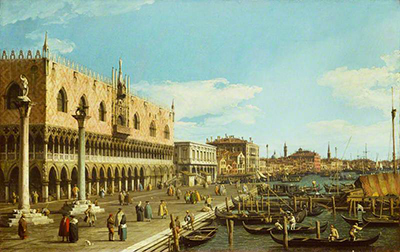Canaletto's love for Venice is seen in nearly all his paintings. He was good in landscape paintings, thanks to his pupillage from his father. His inspiration was derived from Giovanni Pannini's masterpieces on the city. Venice: the Riva degli Schiavoni was painted during his prime years as a topographical painter.
He was at his best, thanks to endorsements from his peers. The painting is one of the most recognisable works of art in Venice, and a precursor to what would be later known as Impressionism. The exact year of production is not clear. However, historians place it between the 1930s to mid-1740s. It shows a fortress on the banks of a river in the foreground. There are boats in the river with people coming in and others roaring out. On the dry land, other people go about their routines, much as a normal metropolis. The fortress in the foreground (Doge's Palace) and the adjacent buildings are a representation of the medieval Italian architectural designs. Typical of Venice, River degli Schiavoni provided a lifeline to the inhabitants. One can understand so much about traditional Venetian architecture just by studying the carefully crafted scenes from Canaletto's career, but it is important to remember that he did sometimes add elements from his own imagination in order to produce the best paintings possible.
He completed this work using oils, one of many paintings produced by Canaletto within, and of, the city of Venice. Others include his first painting Campo San Giacomo di Rialto, Venice (1697-1768), Venice: S. Gerema and the Entrance to Cannaregio (1726/7), Molo View, Venice (1730), Venice: Entrance of the Grand Canal (1730) and The Grand Canal with S. Maria della Salute in Venice, Towards Riva degli Schiavoni (1730). The original painting was 61.3 by 99.8 centimetres. It has since exchanged hands and can now be found at the Wallace Art Collection in the United Kingdom. There are duplicates sold online all over the world by private art collectors and museums. Most of his paintings were sold to King George the III during his Great Tour. There is also today a large print market for those who want to add reproductions of these paintings to their own homes, with his level of detail and colour palettes helping to make him particularly popular.
His love for architecture and nature was the biggest win in his career. He went on a tour in England where he painted and sold a raft of his work. Canaletto's depiction of the topography is exemplary, with attention to detail and precision. He mentored a lot of students but Giuseppe Bernardino Bison took after him holistically. Canaletto was instrumental to the artistic lives of Bernardo Bellotto, Giuseppe Moretti and Michele Marieschi. His style is currently used as a representation of 17th and 18th Century Italy, and specifically the City of Venice. This was an artist whose achievements would inspire many artists right across Europe, and has been linked to the rise of Romanticism and Impressionism across France in later centuries, with a particular connection to the British artists Turner and Constable who would have admired some of the qualities of his drawings and etchings that are known to have impressed many within the UK during his time living there.




